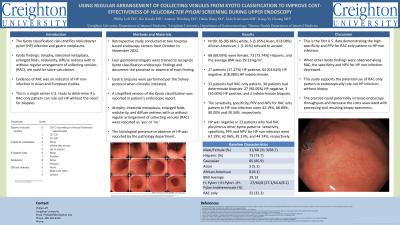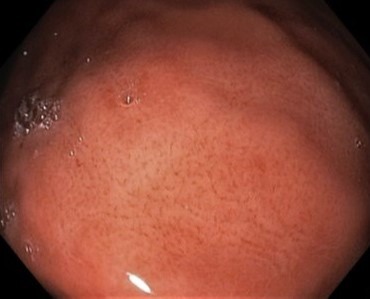Monday Poster Session
Category: Stomach
P2713 - Using Regular Arrangement of Collecting Venules From Kyoto Classification to Improve Cost-Effectiveness of Helicobacter pylori Screening During Upper Endoscopy
Monday, October 23, 2023
10:30 AM - 4:15 PM PT
Location: Exhibit Hall

Has Audio

Phillip Leff, DO
Creighton University
Scottsdale, Arizona
Presenting Author(s)
Phillip Leff, DO1, Ria Kundu, MD2, Andrew Weinberg, DO3, Danlu Wang, DO3, Indu Srinivasan, MD3, Keng-Yu Chuang, MD3
1Creighton University, Scottsdale, AZ; 2Banner Health, Mesa, AZ; 3Valleywise Health, Phoenix, AZ
Introduction: The Kyoto classification was established in 2013 to describe various gastric endoscopic findings and to risk-stratify for Helicobacter pylori (HP) infection and gastric neoplasms. Five endoscopic findings, atrophy, intestinal metaplasia, enlarged folds, nodularity, diffuse redness with or without regular arrangement of collecting venules (RAC), are used for score calculation. Evidence of RAC as an indicator of HP non-infection in Asian and European studies. Here we present data collected from a single U.S. center and propose the use of RAC only pattern to endoscopically rule out HP without the need for biopsies.
Methods: Data was retrospectively collected from patients who received upper endoscopies at two hospital-based endoscopy centers from October to November 2022. Four gastroenterologists were trained to recognize Kyoto classification endoscopic findings and document the presence or absence of each finding. Gastric biopsies were performed per the Sidney protocol when clinically indicated. The histological presence or absence of HP was reported by the pathology department.
Results: A total of 99 patients were analyzed: 85 (85.86%) white, 5 (5.05%) Asian, 8 (8.08%) African American, 1 (1.01%) refused to answer. Additionally, 68 (68.69%) were female, 73 (73.74%) Hispanic, and the average BMI was 29.13 kg/m2. 27 patients (27.27%) were HP positive, 64 (64.64%) were HP negative, and 8 (8.08%) were HP indeterminate. 32 patients had RAC only pattern, 30 patients had determinate biopsies: 27 (90.00%) were HP negative, 3 (10.00%) were HP positive, and 2 had indeterminate biopsies. The sensitivity, specificity, PPV and NPV for RAC only pattern to HP non-infection were 42.19%, 88.89%, 90.00% and 39.34%, respectively. HP was negative in 23 patients who had RAC plus/minus other Kyoto patterns: sensitivity, specificity, PPV and NPV for HP non-infection were 67.19%, 62.96%, 81.13%, and 44.74%, respectively.
Discussion: This is the first U.S. data demonstrating the high specificity and PPV for RAC only pattern to HP non-infection which supports the data published in other countries. When other Kyoto findings were observed along RAC, the specificity and NPV for HP non-infection decreased. This ongoing study supports the potential use of RAC only pattern to endoscopically rule out HP infection without biopsy; the practice could potentially increase endoscopy throughputs and decrease the costs associated with processing and resulting biopsy specimens.

Disclosures:
Phillip Leff, DO1, Ria Kundu, MD2, Andrew Weinberg, DO3, Danlu Wang, DO3, Indu Srinivasan, MD3, Keng-Yu Chuang, MD3. P2713 - Using Regular Arrangement of Collecting Venules From Kyoto Classification to Improve Cost-Effectiveness of Helicobacter pylori Screening During Upper Endoscopy, ACG 2023 Annual Scientific Meeting Abstracts. Vancouver, BC, Canada: American College of Gastroenterology.
1Creighton University, Scottsdale, AZ; 2Banner Health, Mesa, AZ; 3Valleywise Health, Phoenix, AZ
Introduction: The Kyoto classification was established in 2013 to describe various gastric endoscopic findings and to risk-stratify for Helicobacter pylori (HP) infection and gastric neoplasms. Five endoscopic findings, atrophy, intestinal metaplasia, enlarged folds, nodularity, diffuse redness with or without regular arrangement of collecting venules (RAC), are used for score calculation. Evidence of RAC as an indicator of HP non-infection in Asian and European studies. Here we present data collected from a single U.S. center and propose the use of RAC only pattern to endoscopically rule out HP without the need for biopsies.
Methods: Data was retrospectively collected from patients who received upper endoscopies at two hospital-based endoscopy centers from October to November 2022. Four gastroenterologists were trained to recognize Kyoto classification endoscopic findings and document the presence or absence of each finding. Gastric biopsies were performed per the Sidney protocol when clinically indicated. The histological presence or absence of HP was reported by the pathology department.
Results: A total of 99 patients were analyzed: 85 (85.86%) white, 5 (5.05%) Asian, 8 (8.08%) African American, 1 (1.01%) refused to answer. Additionally, 68 (68.69%) were female, 73 (73.74%) Hispanic, and the average BMI was 29.13 kg/m2. 27 patients (27.27%) were HP positive, 64 (64.64%) were HP negative, and 8 (8.08%) were HP indeterminate. 32 patients had RAC only pattern, 30 patients had determinate biopsies: 27 (90.00%) were HP negative, 3 (10.00%) were HP positive, and 2 had indeterminate biopsies. The sensitivity, specificity, PPV and NPV for RAC only pattern to HP non-infection were 42.19%, 88.89%, 90.00% and 39.34%, respectively. HP was negative in 23 patients who had RAC plus/minus other Kyoto patterns: sensitivity, specificity, PPV and NPV for HP non-infection were 67.19%, 62.96%, 81.13%, and 44.74%, respectively.
Discussion: This is the first U.S. data demonstrating the high specificity and PPV for RAC only pattern to HP non-infection which supports the data published in other countries. When other Kyoto findings were observed along RAC, the specificity and NPV for HP non-infection decreased. This ongoing study supports the potential use of RAC only pattern to endoscopically rule out HP infection without biopsy; the practice could potentially increase endoscopy throughputs and decrease the costs associated with processing and resulting biopsy specimens.

Figure: Image of Regularly Arranged Collecting Venules on EGD
Disclosures:
Phillip Leff indicated no relevant financial relationships.
Ria Kundu indicated no relevant financial relationships.
Andrew Weinberg indicated no relevant financial relationships.
Danlu Wang indicated no relevant financial relationships.
Indu Srinivasan indicated no relevant financial relationships.
Keng-Yu Chuang indicated no relevant financial relationships.
Phillip Leff, DO1, Ria Kundu, MD2, Andrew Weinberg, DO3, Danlu Wang, DO3, Indu Srinivasan, MD3, Keng-Yu Chuang, MD3. P2713 - Using Regular Arrangement of Collecting Venules From Kyoto Classification to Improve Cost-Effectiveness of Helicobacter pylori Screening During Upper Endoscopy, ACG 2023 Annual Scientific Meeting Abstracts. Vancouver, BC, Canada: American College of Gastroenterology.
